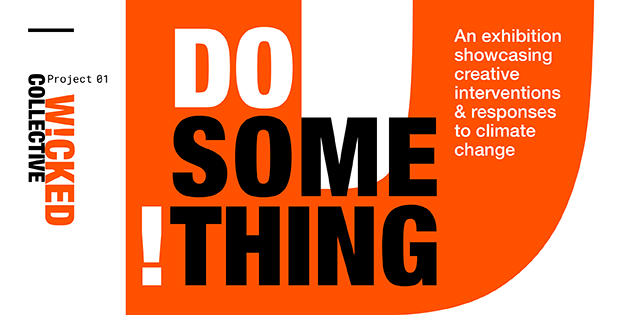Installation image of my recent arts commission from @wollongongcity
The site-specific artwork was made from working, walking, foraging, identifying, mapping and collecting plant material to make colour from the Kembla Grange Cemetery, Wollongong. 36 hand painted and dyed panels reveal the hidden colour of trees from the site to form a contemplative distillation of place.
Thank you to Wollongong Council for such a wonderful opportunity to learn more about nature and our relationship with the land on magnificent Dharawal Country.
!DO SOMETHING
Exhibition: From 12 September to 18 November 2022 (Term 3), UNSW Main Library Level 5
Opening event: Wednesday 21 September, 6pm.
What students and staff from the Arts, Design and Architecture Faculty have been doing in response to the climate change crisis.
Climate Change is the dominant wicked problem of our time: there is no single solution; the boundaries are difficult to define; and it is influenced by complex, interdependent and rapidly changing factors.
In response to Bruce Mau’s MC24 Principle 'New wicked problems demand new wicked teams' (24 Principles for Designing Massive Change in your life and work), The Wicked Collective for Climate Change and Sustainable Development was established in 2021 by five committed academics from the School of Art and Design. We believe that artists, designers, academics, and students need to work together across disciplinary boundaries to effectively respond to the wicked problems confronting us.
This exhibition presents creative responses and interventions to the wicked problem of Climate Change from students and staff across the Faculty of Arts, Design and Architecture (ADA). These works all relate to one or more of the United Nations Sustainable Development Goals, and were created since the formation of ADA in 2020. !DO SOMETHING is part of the ADA Now Festival 2022.
Biomateriality Exhibition - Delmar Gallery 14 May - 12 June 2022
14 May – 12 June
Biomateriality brings together researchers, designers and artists who are pioneering biomaterials in Australia, embracing principles of regenerative design, cyclical economies and interspecies collaboration.
Joining a growing global movement, their research includes developing new materials such as seaweed-based polymers for 3D printing, biofoams and mycelium applications in the construction, packaging, design and textile industries.
This exhibition goes behind their studio and lab doors and reveals this research in progress, including material experiments, speculative design, prototypes and samples. It will also include art installations that explore the new aesthetics and philosophical implications of this emerging field of design.
JOANNA FOWLES
KATH FRIES
FUNGI SOLUTIONS
MICOEDEN
PHILIPPA ABBOTT, EDWARD LINACRE, MATT WOODS, MYCELIUM STUDIOS
ALIA PARKER
JOSH RIESEL
STUDIO FLEK
SUSTINENT & ELLEN FERRIER
MONASH, RMIT AND SWINBURNE DESIGN STUDENTS WITH GYUNGJU CHYON, JOHN SADAR & CANHUI CHEN
NAHUM MCLEAN, KATE SCARDIFIELD AND ELLA WILLIAMS, MATERIAL ECOLOGIES LAB, UTS
Exhibition opening: Saturday 14 May, 3 – 5pm
with artist & designer talks by Alia Parker, Josh Riesel and Kate Scardifield
Panel discussion: Sunday 22 May, 2.30pm
Panellists: Amanda Morglund, CEO, Fungi Solutions
Daniel Goldsmith, founding director, Micoeden
Nahum McLean, academic and biobased materials researcher, UTS
Free admission, registration required.
Exhibition dates: 15 May – 12 June, 2022
Gallery hours: Wednesday – Sunday, 12-5pm. Free admission.
Mass Reduction Exhibition - Melbourne Design Week 2022
Thursday, March 17, 2022 to Friday, June 3, 2022
Mass Reduction presents the work of artists and designers who through playful transformation of textile remnants and interrogation of linear modes of textile consumption offer innovative creative design approaches to confronting textile waste.
These works provide an antithesis to heedless textile production by championing mending and embracing wear and tear, privileging waste materials in design, slow process and repurposing and reusing textile waste. As well as through material choices, many artists employ a theoretical investigation into how we create and consume textiles and invite reflection on the value of post-consumer materials.
Presented as part of Melbourne Design Week, ‘Mass Reduction’ speaks to broader concerns around the waste created by the textile and apparel industries and current modes of ‘end-of-life' resource consumption. This exhibition promotes rethinking design process and material choices, reduce environmental impact and posit the transformation of textile waste to an even higher value textile product.
Artists: Eileen Braybrook (VIC), Aaron Billings (VIC), Elise Cakebread (VIC), Aphra Cheesman (VIC), Joanna Fowles (NSW), Blake Griffiths (NSW), Eloise Rapp (NSW), RaasLeela (INDIA), Reiko Sudo/NUNO (JPN) and Lisa Waup (Gunditjmara/Torres Strait Islander/VIC).
Dyevert shirt - Wins the Northern Beaches Environmental Art Prize 2021
Delighted to be the recipient of the inaugural Northern Beaches Environmental Art & Design Prize.
Thank you to everyone especially my co-collaborator Nina Smith for realising such a beautifully crafted garment.
The shirt utilises food waste and zero waste pattern cutting techniques to reimagine overlooked waste materials. The DYEVERT shirt demonstrates the potential of sustainable practice within textiles by applying circular design processes. I identified waste streams transforming discarded food waste into a dye resource to colour the shirt. Each stripe in the shirt is hand-painted using a traditional textile technique revealing multiple colours after dyeing the cloth in vegetal waste. Nina Smith then applied zero-waste pattern techniques to minimise waste in the garment design and construction process.
Both designers are responding to the systemic issues of fast fashion and the landfill of textiles. The ongoing collaboration demonstrates a less impactful garment that can be recoloured multiple times with other food waste to reactivate the stripes. The garment can eventually return to the earth and decompose.





